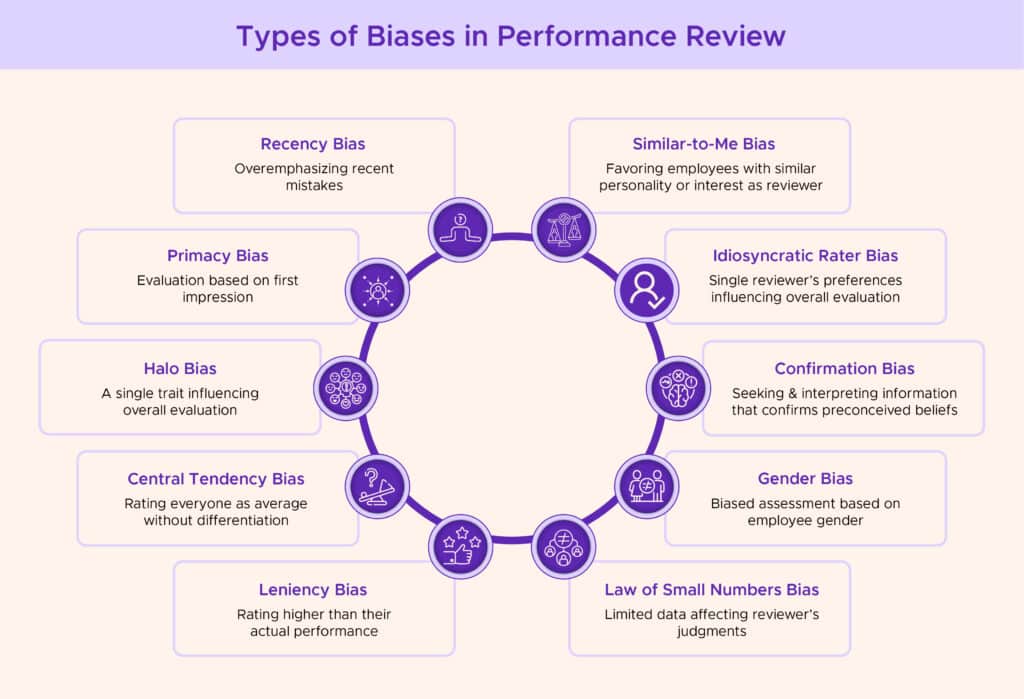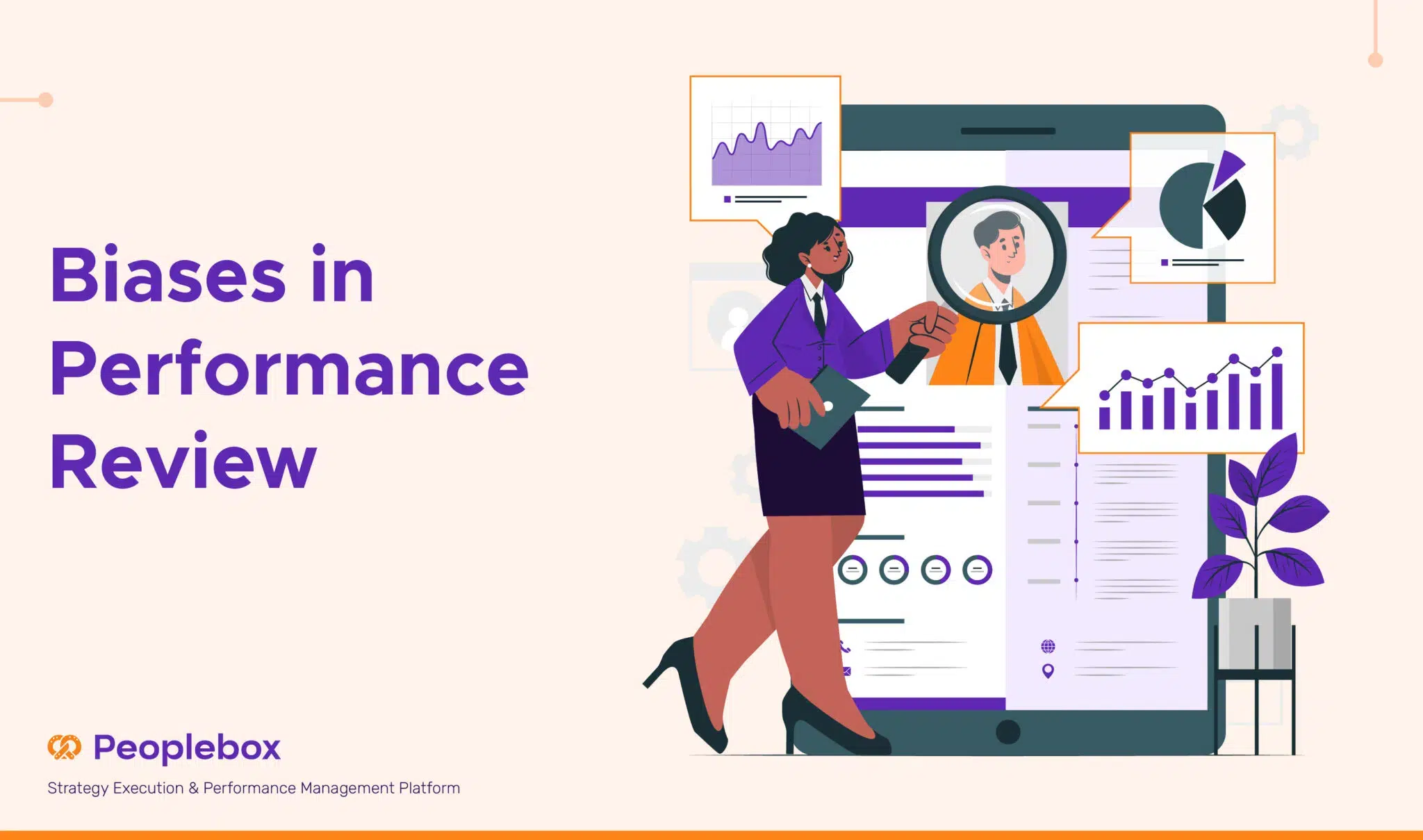
Imagine you’re standing on a tightrope, balancing your professional future. On one side, there’s the hope of fair and constructive feedback, leading to growth and success. On the other, hidden biases threaten to tip the scales, altering your performance review’s true purpose. In the world of performance evaluations, these biases often lurk unnoticed, affecting outcomes. Join us on this journey as we uncover ten common performance review biases, provide real-life examples, and equip you with strategies to evade their influence.
In this article, we aim to shed light on the pervasive biases that can distort performance reviews, offer concrete examples of each bias, and provide practical strategies to mitigate their impact.
10 Common Biases That Skew Performance Reviews
Even well-meaning managers can fall into these traps. Here’s a breakdown of the most frequent biases to watch out for—and what they really mean:
| No. | Type of Bias | Description |
|---|---|---|
| 1 | Recency Bias | When fresh memories cloud the past |
| 2 | Primacy Bias | The power of first impressions |
| 3 | Halo/Horns Effect Bias | The tendency to let one trait overshadow others |
| 4 | Centrality Bias | Playing it safe by rating everyone average |
| 5 | Leniency Bias | The trap of being overly generous |
| 6 | Similar-to-Me Bias | Favoring those who resemble ourselves |
| 7 | Idiosyncratic Rater Bias | Letting personal standards skew evaluations |
| 8 | Confirmation Bias | Seeking evidence that confirms our beliefs |
| 9 | Gender Bias | Letting gender stereotypes influence judgments |
| 10 | Law of Small Numbers Bias | Overgeneralizing from a small sample of data |
Now that you’re familiar with the most common biases in performance reviews, let’s dive deeper into each one—along with the mitigation strategies to handle them effectively.

1. Recency Bias: When Fresh Memories Cloud the Past
Imagine a colleague who recently made a significant mistake just before the year-end review. The recency bias might lead the reviewer to overemphasize this incident, affecting the overall evaluation.
Mitigation Strategy: Maintain a performance log throughout the year to ensure that reviews are based on a comprehensive view of an employee’s performance rather than recent events.
2. Primacy Bias: The Power of First Impressions
First impressions can be lasting. An employee who starts strong in a new role may have the primacy bias working in their favor. Conversely, a shaky start can cast a shadow throughout the review period.
Mitigation Strategy: Encourage reviewers to weigh each aspect of an employee’s performance independently, separating initial impressions from ongoing contributions.
3. Halo/Horns Effect Bias: The Tendency to Overshadow
The halo effect occurs when one outstanding trait overshadows other aspects of an employee’s performance. Conversely, the horns effect lets a single negative aspect disproportionately influence the overall evaluation.
Mitigation Strategy: Use a structured rating scale for each criterion to ensure a comprehensive assessment rather than relying on a single trait or flaw.
4. Centrality/Central Tendency Bias: Stuck in the Middle
Some reviewers tend to rate all employees as average, avoiding extreme ratings. This central tendency bias can hinder differentiation between exceptional and underperforming employees.
Mitigation Strategy: Provide clear examples and criteria for each rating level to guide reviewers in making more accurate assessments.
5. Leniency Bias: The Trap of Generosity
Leniency bias involves consistently rating employees higher than their actual performance. This can lead to a skewed distribution of performance ratings.
Mitigation Strategy: Standardize the performance evaluation process by offering specific criteria and examples for each rating level. Train reviewers to calibrate their judgments.
6. Similar-to-Me Bias: Birds of a Feather Flock Together
Reviewers may unconsciously favor employees who are similar to them in terms of background, personality, or interests, leading to biased evaluations.
Mitigation Strategy: Encourage diversity and inclusion in your organization, and consider involving multiple reviewers in performance evaluations to counter this bias.
7. Idiosyncratic Rater Bias: One Person’s Opinion
Idiosyncratic rater bias occurs when a single reviewer’s personal preferences and biases heavily influence an employee’s evaluation.
Mitigation Strategy: Involve multiple reviewers to provide a more balanced and objective assessment.
8. Confirmation Bias: Seeking What We Want to See
Reviewers sometimes seek or interpret information that confirms their preconceived beliefs about an employee, leading to biased assessments.
Mitigation Strategy: Encourage reviewers to approach evaluations with an open mind and focus on objective criteria rather than personal beliefs.
9. Gender Bias: A Biased Lens

Gender bias can impact how employees are evaluated, with research showing that women often face harsher criticism and higher standards.
Mitigation Strategy: Implement blind reviews, where employee identities are concealed during evaluations, to reduce gender bias.
10. Law of Small Numbers Bias: Extrapolating from Limited Data
Sometimes, limited data leads reviewers to make sweeping judgments about an employee’s performance based on a small sample of information.
Mitigation Strategy: Emphasize the importance of considering a broader dataset when evaluating employee performance.
Conclusion: Navigating the Maze of Biases
Performance reviews are invaluable tools for personal and professional growth. By understanding and mitigating these biases, we can make the process fairer and more effective for everyone involved. As you embark on your next performance review cycle, armed with this knowledge, remember that awareness is the first step toward meaningful change.
In the world of performance reviews, biases are the hidden dragons we must confront. With the right knowledge and strategies, we can tame these dragons and ensure that the tightrope of fairness remains unshaken in our professional journey.
What are biases in performance review?
Performance review biases are unconscious distortions or prejudices that affect how managers evaluate employee performance, often leading to unfair assessments.
Why does spotting bias in performance reviews matter?
They impact employee morale, promotion fairness, and workplace equality. Biases can lead to talent being overlooked and poor decision-making in people management.
What are the most common performance review biases?
Some of the most common include recency bias, primacy bias, halo/horns effect, central tendency, leniency bias, and gender bias.
How can companies reduce performance review bias?
Use structured review forms, regular feedback cycles, multiple reviewers, and bias-awareness training to reduce subjectivity and improve fairness.








